These calligraphers turned out to be one family!
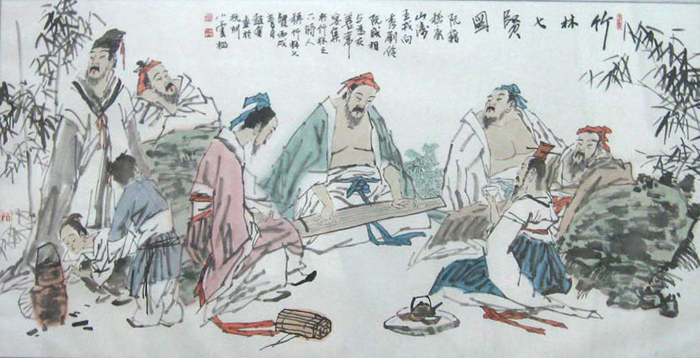
Compiled | Calligraphy Jun
For us, we only need to forward a circle of friends with one click to connect the two most distant people. But in ancient times, it took two or three years to take the college entrance examination. When your lover misses you, you can't check your friends. What should you do? I can only look at the moon quietly, the bright moon expresses my longing for each other, and we share the beauty of the moon thousands of miles apart. In an environment where transportation and information are extremely underdeveloped, the circle of friends is closed, and the relationship chain is extremely short, being in the same hometown is a very close thing. Can they still have the same name? That’s almost like a family!
I used to be particularly curious about the relationship between ancient calligraphers. When I talked about Tang Dynasty calligraphy at the Lanting Study Group, I also introduced the relationship between several great calligraphers in the Tang Dynasty. Today, if you take a closer look, you will find that these great calligraphers in ancient times are all closely or remotely related. They may be equally famous in the same generation, compete with masters and apprentices, or be passed down from generation to generation. I like calligraphy and it’s very interesting to learn about the ancient circles!

Zhang Zhi's "Champion Post" (perhaps said to be written by Tang Zhangxu)
Zhang Zhi, Caosheng, Suo Jing’s grandma’s younger brother
The year of his birth is unknown, but he died in the third year of Emperor Xian's reign of the Han Dynasty (about 192 AD). He was born in Jiuquan, Dunhuang (now part of Gansu Province). His courtesy name was Boying, and he was good at Zhangcao. "Jincao", Wei Dan, the calligrapher of Wei Dynasty in the Three Kingdoms, called him the "Sage of Grass". It had a profound influence on later generations Wang Xizhi and Wang Xianzhi's cursive calligraphy.

Zhong Yao's "Declaration Form"
Zhong Yao (151-230), Mrs. Wei and Wang Xizhi’s calligraphy benefited from Zhong Yao
A calligrapher from the Wei Dynasty in the Three Kingdoms, his courtesy name was Yuan Chang. During the Ming Dynasty, he was granted the title of Marquis of Dingling and moved to Taifu, known as "Taifu Zhong". Zhong Gong was a calligrapher and learned calligraphy from Cao Xi, Liu Desheng, and Cai Yong. It is said that the tomb of Yinfa Wei Dan obtained Cai Yong's calligraphy theory, and his calligraphy skills greatly improved. His regular script calligraphy was unparalleled at that time. He studied calligraphy carefully for thirty years, and his works are beautiful, elegant and profound.

Lu Ji's "Pingfu Tie"
Western Jin Dynasty, Lu Ji, brother of writer Lu Yun;
Lu Ji and Lu Jianzhi, a calligrapher of the Tang Dynasty, were both from Suzhou. The former wrote articles in "Wen Fu" and the latter left behind calligraphy in "Wen Fu";
In the same year that Lu Ji died, Suo Jing died. In this same year, the great calligrapher Wang Xizhi was born.
Lu Ji (261-303), courtesy name Shiheng, was a native of Wu County (now Suzhou, Jiangsu Province). Because it was once the plain's inner history, it is called Lu Pingyuan in the world. He is "a rare genius, with the best articles in the world" ("Jin Shu Lu Ji Biography"). Together with his younger brother Lu Yun, he was a famous writer in my country's Western Jin Dynasty. In fact, Lu Ji was also an outstanding calligrapher. His "Pingfu Tie" It is the earliest authentic Dharma calligraphy of famous people that has survived in ancient my country.
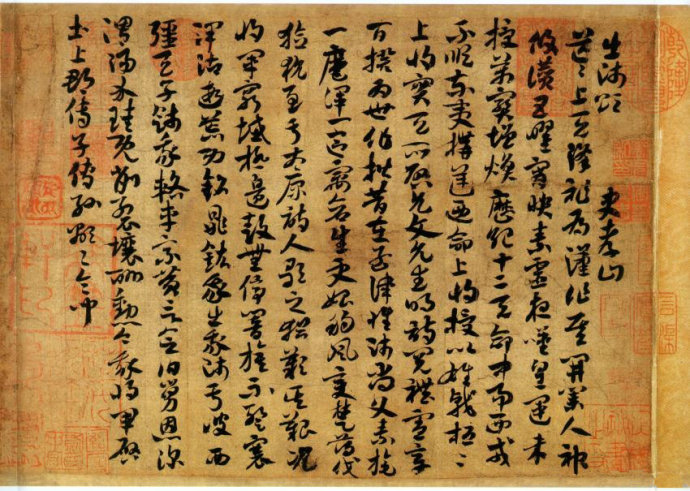
Suo Jing's "Ode to Become a Teacher" Volume (Biography)
Suo Jing (239-303), grandson of Zhang Zhi's sister
Suo Jing is a famous calligrapher in the Western Jin Dynasty. The courtesy name is You'an, a native of Dunhuang (now Gansu). He was a minister in official history and the prefect of Jiuquan. He was the Sima of Zhengxi, and he was known as "Suo Zhengxi". Skilled in calligraphy, especially Zhangcao. He Shangshu ordered Wei Guan to be famous for his cursive script, and was known as "One Taiwan and Two Wonders" at that time. Jing spread Zhang Zhi's grass method and changed his appearance. The bones are strong and strong, and the writing is full of power. The predecessors rated it as "extremely skilled, not as good as Zhang; full of charm, not as good as Zhang". Jing also valued his book and named it "Yin Gou Hao Wei".

Wei Guan's "Dunzhou Tie"
Wei Guan is as famous as Suo Jing, and his nickname is "One Taiwan and Two Wonders"
Wei Guan worked in cursive script. He learned from Zhang Zhi's "Jincao" in the Han Dynasty, and also consulted the cursive calligraphy of his father Wei Jian. His writing style is vertical and horizontal, elegant and majestic. He was as famous as Suo Jing, another famous calligrapher at that time, and was known as "One Taiwan and Two Wonders" at that time. The so-called "Tai" refers to the fact that both of them were officials in Taiwan Province, with Guan as Shangshu Ling and Jing as Shangshu Lang. The so-called "two wonderful" means that both of them have extremely high attainments in cursive calligraphy, and each has his own uniqueness. Zhang Huaiguan of the Tang Dynasty rated his chapters as "superior" in his "Shujuan".

Wei Heng's calligraphy "Four Body Calligraphy Movements" (detail)
Wei Heng, son of Wei Guan
Wei Heng's calligraphy theory work "Four Body Calligraphy Movements" is one of the earliest and relatively reliable important calligraphy theories in the world, and has high historical value. Most of the information about various calligraphy styles at that time, the evolution of calligraphy history, and the situation of some calligrapher representatives depend on this book to be preserved.
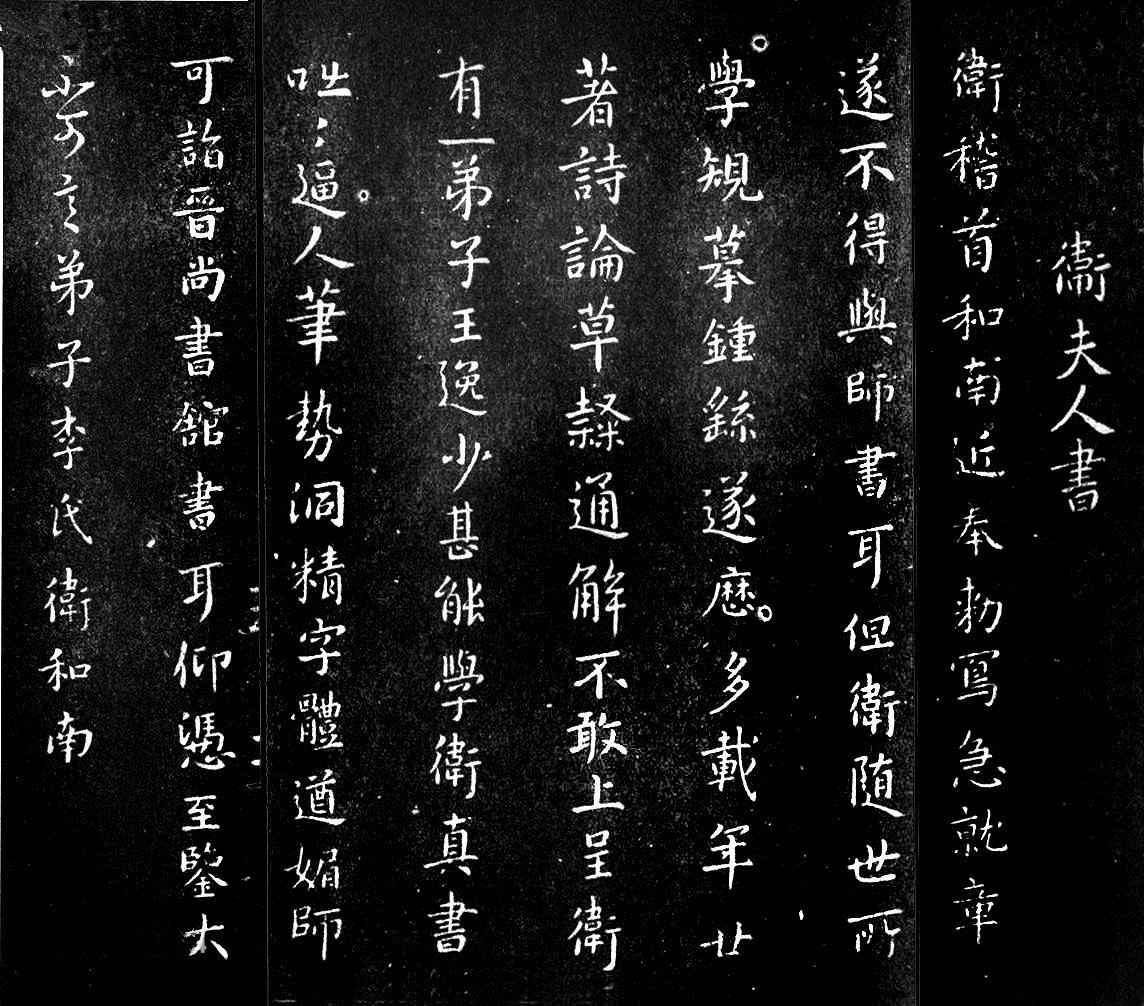
Mrs. Wei's "Recent Blessings"
Wei Shuo, Mrs. Wei, Wei Heng’s younger sister;
Wang Xizhi studied calligraphy under his disciples
Wei Shuo is the well-known female calligrapher Mrs. Wei. Mrs. Wei was eager to learn and loved the art of calligraphy. She learned calligraphy from the great calligrapher Zhong Yao very early on. She wrote the volume "Bi Zhen Tu", which comprehensively and in-depth explains the theory of calligraphy.
Calligraphers have always been puzzled by the fact that Mrs. Wei studied under Zhong Yao. Wei Shuo's father was as famous as Suo Jing. Suo Jing was born in 239, and Zhong Yao had been dead for 9 years. Logically speaking, Zhong Yao might not be alive when Wei Shuo's father was born, and it would be even less likely for Mrs. Wei to become a disciple of Zhong Yao. Therefore, either the rumors are wrong, or the saying of using Zhong as a teacher refers to studying his handwriting.
Wei Hong and Wei Jie, sons of Wei Heng
Both are also famous calligraphers.

Wang Xizhi's "Yuanhuan Tie"
Wang Xizhi (303-361), learned calligraphy from Mrs. Wei
He was a calligrapher in the Eastern Jin Dynasty with a few words. He was originally from Langya (now Linyi, Shandong) and lived in Shanyin, Huiji (Shaoxing, Zhejiang). From official to general of the right army, he was an internal historian of Kuaiji and was known as "Wang Youjun". He was born into a prominent family in the Jin Dynasty. As a child, he learned calligraphy from Mrs. Wei, a famous female calligrapher at the time. After that, he crossed the Yangtze River and traveled to famous mountains in the north, learning from everyone's strengths. He learned from Zhang Zhi, a master of cursive calligraphy, and learned from Zhong Yao in his official calligraphy. Observing and learning the "methods of gathering together people to prepare a family", reaching the height of "Guiyue Group's products are the best in ancient and modern times".
Among the four major families of the Eastern Jin Dynasty: Wang, Xie, Xi, and Yu, the most prominent is the Wang family, and the Wang family deserves to have the most outstanding achievements in calligraphy. The Wang family has the most calligraphers. In this calligraphy family, there are fathers and sons competing for victory, brothers competing, husbands and wives competing, in-laws learning from each other, and passing on each other. This is not only extremely dazzling in the history of calligraphy, but also unique in the history of world art. In particular, there appeared the sage Wang Xizhi and his seventh son Wang Xianzhi. The father and son were collectively called the "Two Kings" by the world. This is the pride of the Wang family, and this is also the pride of Eastern Jin calligraphy.
Wang Xizhi's sons are all good at calligraphy. His son Xuanzhi was good at cursive calligraphy; Ningzhi was good at cursive calligraphy; Huizhi was good at Zheng cursive calligraphy; Cao Zhi was good at Zheng cursive calligraphy; Huanzhi was good at Zheng cursive calligraphy; and Xian was called "Little Sage".

Wang Xianzhi's "Luo Shen Fu"
Wang Xianzhi, the seventh son of Wang Xizhi
Wang Xianzhi, also known as Zijing, also known as Guannu, was known as "Wang Daling" in the world. His calligraphy is in regular script, running script, cursive script, and official script. Xianzhi learned from his father as a child, and he has shown superhuman talents since he was a child. He is extremely talented and aggressive. Xianzhi is not restricted by his father.
Calligrapher, here is some gossip. Wang Xianzhi was the most romantic and elegant at the time. He and his cousin were originally in love, and they were like a perfect couple. Unfortunately, being too handsome is not a good thing. Unfortunately, Xian's brother was spotted by Princess Xin'an, and the pair of mandarin ducks were torn apart. The cousin died of depression after being divorced, which deepened Wang Xianzhi's longing and guilt for her. He was depressed all his life and died young in his forties.
Who is his first wife and cousin? Her name is Xi Daomao, she is the granddaughter of Xi Jian (the daughter of his second son). Who is Xi Jian? Remember the story of Dong Bed Kuai Hui, the minister of the Eastern Jin Dynasty who sent his daughter to a guy who was lying on the bed eating with his belly exposed.
When you talk about it, it’s all a story!

Wang Huizhi, Crescent Post
Wang Huizhi, the fifth son of Wang Xizhi, the fifth brother of Wang Xianzhi

Wang Hui's "Weng Zun Ti"
Wang Hui (464-549), cousin of Wang Xizhi, sixth son of Wang Dao, uncle of Wang Xun
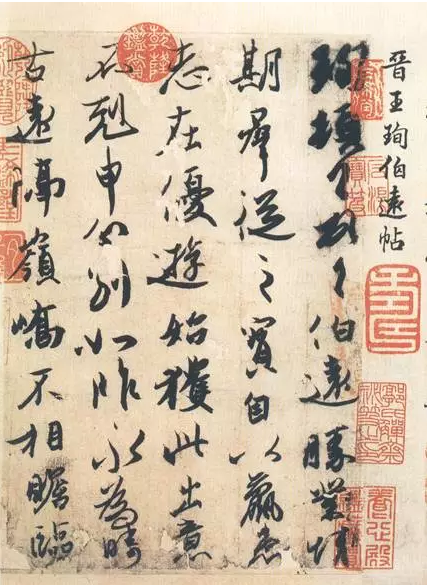
Wang Xun's "Bo Yuan Tie"
Wang Xun, Wang Xizhi is his cousin, he and Xianzhi are cousins
The character Yuan Lin, the small character Dharma Protector. Langya was born in Linyi (now Linyi, Shandong) and was born into the Wang family of the Eastern Jin Dynasty. Both his grandfather Wang Dao and his father Wang Qia were good at calligraphy. His "Bo Yuan Tie" is a very rare authentic calligraphy by a famous person in the Eastern Jin Dynasty, and it is the only authentic calligraphy of the Wang family in the Eastern Jin Dynasty. It has always been regarded as a rare treasure by calligraphers, collectors and connoisseurs.
"Bo Yuan Tie" written by him is the only surviving authentic work of the Wang family in the Eastern Jin Dynasty. Who is Boyuan in this letter? That is Wang Xizhi's eldest son, Wang Xuanzhi. They are somewhat distant cousins.

Wang Zhi "No application for a day"
Wang Zhi (460-513), son of Wang Sengqian
Zi Cidao, a native of Linyi, Langya. Wang Monk Qianzi. "Book of Liang" Volume 21 "Biography of Wang Zhi": "Zhi Shan Cao Li, at that time thought it was regular script."

Wang Ci's "Caijiu" and "Rubi" Posts
Wang Ci (451-491), son of Wang Sengqian
His courtesy name was Bo Bao, a native of Linyi (now Linyi, Shandong Province). Monk Qianzi. Shao studied calligraphy with his younger brother Jian. Good at writing and writing. Wang Ci's cursive calligraphy is full of roundness and solemn connotation, but his body is very agile and vertical and horizontal, which reminds people of Wang Xianzhi's calligraphy style.
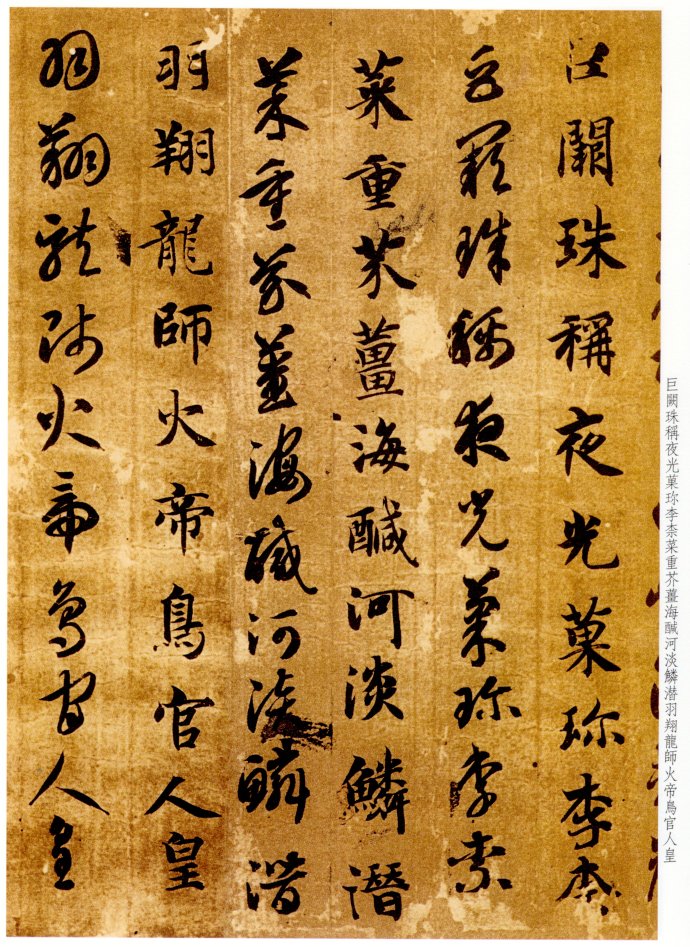
Zhiyong's "The Thousand-Character Essay on True Grass"
Zhiyong, the seventh generation grandson of Wang Xizhi
Zhiyong, whose surname was Wang, was a monk of Yongxin Temple in Shanyin. His name was Faji, and he was known as "Yongzen Master". He was a famous calligrapher between the Chen and Sui Dynasties.

Yu Shinan (558-638), with Zhiyong as his mentor
Yu Shinan is Lu Jianzhi’s uncle
Yu Shinan is a good friend with Ouyang Xun
Yu Shinan had a close relationship with Monk Sun Zhiyong, the seventh generation of Wang Xizhi. Under Zhiyong's careful teaching, his calligraphy was wonderful, mellow and beautiful, soft on the outside and strong on the inside. He inherited the calligraphy tradition of the two kings (Wang Xizhi and Wang Xianzhi). Among the masters of regular script in the Tang Dynasty, he was closest to the two kings, especially Xiao Wang.

Chu Suiliang's "Preface to the Holy Religion of the Wild Goose Pagoda"
Chu Suiliang succeeded Yu Shinan and became a good pen pal of Emperor Taizong of the Tang Dynasty
Emperor Taizong of the Tang Dynasty once said: "After the death of Yu Shinan, no one will discuss calligraphy with me anymore." Wei Zheng recommended Chu Suiliang, saying, "Suiliang's penmanship is vigorous and powerful, and he is even more like Wang Yishao's style."
Chu Suiliang, courtesy name Dengshan, was born in Qiantang, Zhejiang (now Hangzhou City). During the reign of Emperor Taizong of the Tang Dynasty, he was granted the title of Duke of Henan Province and was known as "Chu Henan" in the world. At that time, he was as famous as Ou and Yu and was one of the four great calligraphers in the early Tang Dynasty. Yan Zhenqing was also influenced by him. "Book Review of the Tang Dynasty" said that Chu's book is "gold in the words, jade in the lines, gentle in rules, and beautiful in many ways."
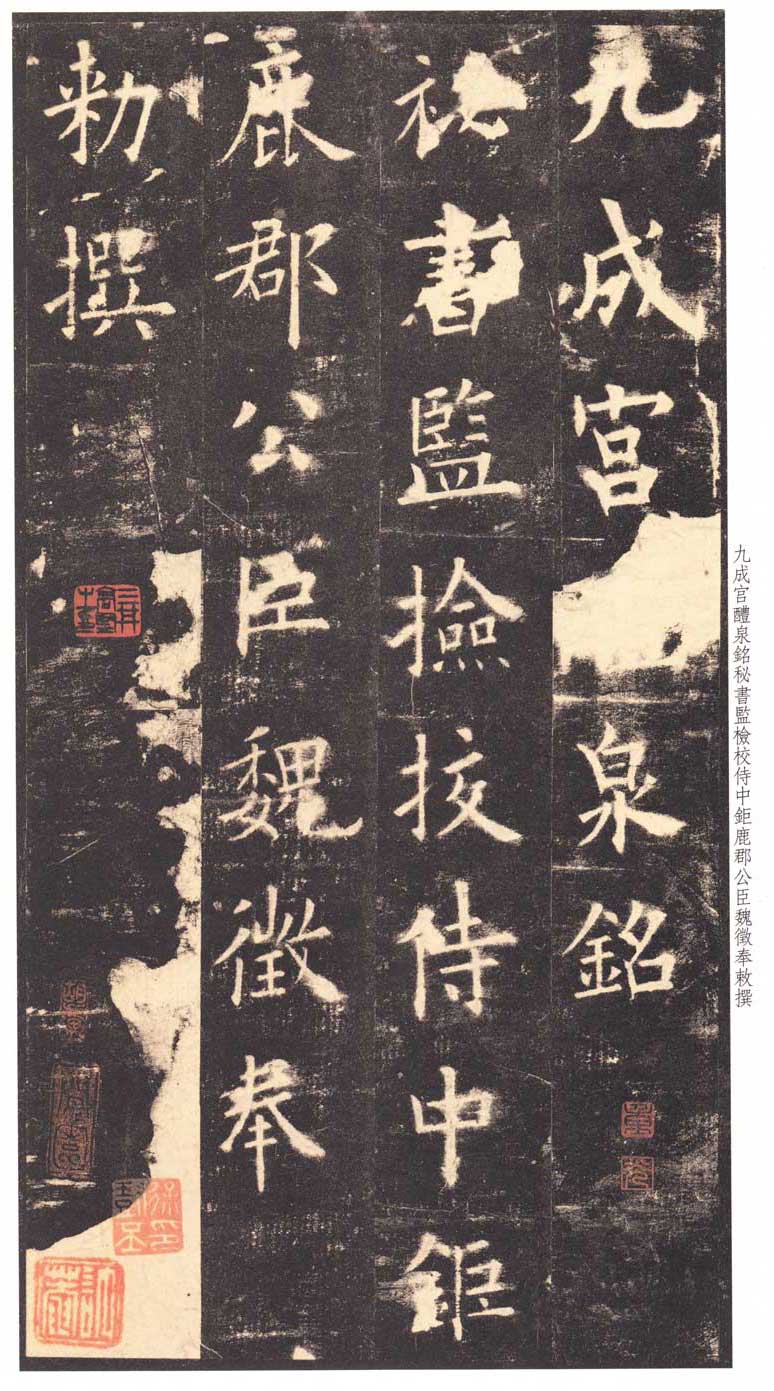
Ouyang Xun's "Jiucheng Palace Liquan Inscription"
Ouyang Xun (557-641), befriended Yu Shinan
Ouyang Xun was one year older than Yu Shinan and lived three years longer than Yu. Once when he and Yu Shinan were out, they saw a stele written by Suo Jing, a calligrapher of the Jin Dynasty. He sat on the ground beside the stele and carefully observed, copied and studied it for three days. Legend has it that Ouyang Xun once paid a lot of money to buy the "Zhigui Tu" used by Wang Xizhi to teach his children to practice calligraphy, and he copied and studied it day and night.

Ouyang Tong's "Stele of Master Daoyin" (detail)
Ouyang Tong, son of Ouyang Xun, mastered calligraphy

Lu Jianzhi's "Wen Fu"
Lu Jianzhi, Yu Shinan’s nephew
A niece of Lu Jianzhi, Zhang Xu’s mother (Lu family)
Lu Jian's representative calligraphy "Wen Fu" was written by Lu Ji in the Western Jin Dynasty, both of whom were from Suzhou. When Lu Jianzhi was young, he learned calligraphy from his uncle's family. His uncle was Yu Shinan, a very famous calligrapher at that time.

Zhang Xu's "Four Ancient Poems"
Zhang Xu, whose mother is Lu Jianzhi’s niece
Zhang Xu had a disciple named Wu Tong, and Wu Tong had a disciple named Huai Su.
Yan Zhenqing once asked Zhang Xu for advice on brushwork
Zhang Xu is free and uninhibited, open-minded, outstanding, talented and knowledgeable. Being friendly with Li Bai and He Zhizhang, Du Fu listed the three of them among the "Eight Immortals in Drinking". Hou Huaisu inherited and developed his writing style, which was also named after cursive script, and was also called "Dian Zhang Zuisu". Emperor Wenzong of the Tang Dynasty once issued an edict to regard Li Bai's poetry, Pei Min's sword dance, and Zhang Xu's cursive calligraphy as the "three wonders". He also worked in poetry, and together with He Zhizhang, Zhang Ruoxu and Bao Rong, he was known as the "Four Scholars in Wuzhong".
The calligrapher couldn't help but admire: These people are Chow Yun-fat, Andy Lau, Jacky Cheung and Tony Leung of the Tang Dynasty, shining like bright stars in the night sky of the Tang Dynasty.
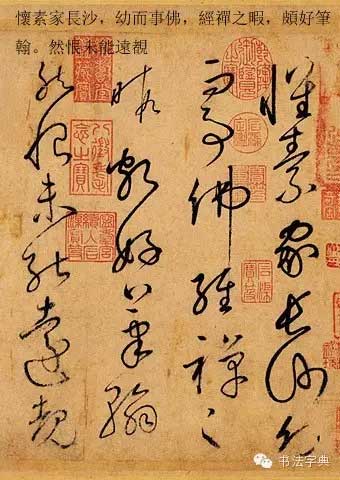
Huai Su's "Autobiography"
Huai Su was a disciple of Wu Tong, and Wu Tong was a disciple of Zhang Xu.
Huai Su and Wu Tong are still middle cousins
Zhang Xu privately said to Tong again: "The lonely canopy vibrates on its own, the startled sand flies on its own, and the rest of the teachers are writing books, so it's strange. All the saints have used up all the firewood for writing." Huaisu could no longer respond, but continued to shout for dozens of times. The voice said: "You've got it!"

Yan Zhenqing's "Duobao Pagoda Stele"
Yan Zhenqing (709-785) once asked Zhang Xu for advice on brushwork
Lu Yu of the Tang Dynasty recorded in "Shi Huaisu and Yan Zhenqing Discussing Cursive Script": Yan Zhenqing and Huai Su discussed calligraphy, and Huai Su said: "I see many strange peaks in the summer clouds, and I often use them. The pleasure is like birds coming out of the forest, and snakes entering the grass. , and like the road on the wall, all natural." Yan Zhenqing said: "How is it like the leakage marks in the house?" Huai Su stood up, took the male hand and said: "I got it!"

Xu Hao's "Zhu Juchuan's Prosecution"
Xu Hao (703--782) was born at the same time as Yan Zhenqing and was also about the same age when he died.
The two are both court officials and calligraphy giants.
Xu Hao's book titles at that time ranked higher than Yan Zhenqing's. Xu Hao, whose courtesy name is Ji Hai, received calligraphy from his father. Less and fresh, it goes with Chu and Xue on the shoulders; it becomes old and heavy in the later years, and the essence is Xi and Xian. Its main book can be said to be wonderful and wonderful, with eight points, truth and practice all in it. Xu Hao served in the central government and wrote a large number of official appointment and notification documents for the imperial court. At that time, he was highly regarded by the emperor and his books had high titles.
Of course, the above list is only a very small part. In fact, there are many calligraphers in ancient times who are inextricably linked with each other. For example, the father and son Mi Fumi and Mi Youren, Su Shi's father, brothers and several sons, the emperor's calligraphers such as Song Huizong Zhao Ji and Gaozong Zhao Gou, the Cai Jing brothers and their sons, Zhao Mengfu and his wife Duan Sheng, his son Zhao Yong, and his grandson Zhao Lin, his grandson Wang Meng (one of the four Yuan families), brothers Shen Du and Shen Can, Wen Zhengming and his son, etc.








